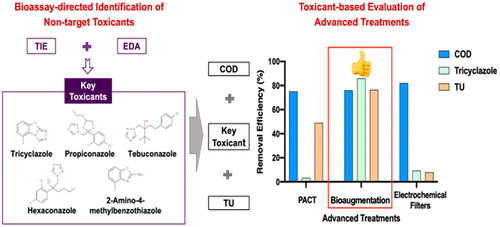当前位置:
X-MOL 学术
›
Environ. Sci. Technol. Lett.
›
论文详情
Our official English website, www.x-mol.net, welcomes your
feedback! (Note: you will need to create a separate account there.)
Biodirected Identification of Untargeted Toxicants in Industrial Wastewater Guides the Upgrading of Water Treatments
Environmental Science & Technology Letters ( IF 8.9 ) Pub Date : 2021-05-05 , DOI: 10.1021/acs.estlett.1c00277 Jing Guo 1 , Dongyang Deng 1 , Jingfan Qiu 2 , Jinyou Shen 3 , Lianjun Wang 3 , Si Wei 1 , Xiaowei Zhang 1 , Qing Zhou 1 , Hongxia Yu 1 , Wei Shi 1, 4, 5
Environmental Science & Technology Letters ( IF 8.9 ) Pub Date : 2021-05-05 , DOI: 10.1021/acs.estlett.1c00277 Jing Guo 1 , Dongyang Deng 1 , Jingfan Qiu 2 , Jinyou Shen 3 , Lianjun Wang 3 , Si Wei 1 , Xiaowei Zhang 1 , Qing Zhou 1 , Hongxia Yu 1 , Wei Shi 1, 4, 5
Affiliation

|
Because industrial wastewater contains numerous chemicals and transformation products (TPs), it is important to select efficient wastewater treatments to remove toxic pollutants and their related toxicity. An integrated framework for biodirected identification of untargeted toxicants in industrial wastewater and evaluation of water treatments considering the removal of causative toxicants and overall toxicity was developed. A suite of in vivo bioassays, untargeted screening, and TP prediction were combined and applied to typical industrial wastewater. The wastewater was highly toxic with a toxic unit (TU) of 18.62, and organic substances were characterized as the main toxicants. Twelve untargeted structures and 13 of 338 TPs were tentatively identified in highly toxic fractions. Four contaminants (tricyclazole, tebuconazole, propiconazole, and hexaconazole) and one TP (2-methyl-4-benzothiazole) were confirmed as causative toxicants, with tricyclazole contributing the most (≤21%) to the detected TU. Further evaluation showed that although all of the chosen advanced treatments could reduce the chemical oxygen demand efficiently, bioaugmentation with sp. NJUST37 was finally promoted, which removed 77% of TUs and 86% of tricyclazole, while activated carbon and electrochemical filters showed limited removal of the dominating toxicant and its related toxicity. Bioassay-directed analysis may greatly improve the identification of untargeted toxicants in wastewater and the upgrading of water treatments.
中文翻译:

工业废水中非目标有毒物质的生物定向鉴定指导水处理升级
由于工业废水含有大量化学品和转化产物 (TP),因此选择有效的废水处理方法以去除有毒污染物及其相关毒性非常重要。开发了一个综合框架,用于工业废水中非目标毒物的生物定向识别和考虑去除致病毒物和整体毒性的水处理评估。将一套体内生物测定、非靶向筛选和 TP 预测相结合,并应用于典型的工业废水。废水剧毒,毒性单位(TU)为18.62,主要毒物为有机物。12 个非靶向结构和 338 个 TP 中的 13 个在剧毒组分中初步鉴定。四种污染物(三环唑、戊唑醇、丙环唑、和己康唑)和一种 TP(2-甲基-4-苯并噻唑)被确认为致病毒物,其中三环唑对检测到的 TU 贡献最大(≤21%)。进一步的评估表明,尽管所有选择的高级处理方法都可以有效地降低化学需氧量,但使用 sp 进行生物强化。NJUST37 最终得到推广,它去除了 77% 的 TU 和 86% 的三环唑,而活性炭和电化学过滤器显示出对主要毒物及其相关毒性的去除有限。以生物测定为导向的分析可能会大大改善废水中非目标有毒物质的识别和水处理的升级。进一步的评估表明,尽管所有选择的高级处理方法都可以有效地降低化学需氧量,但使用 sp 进行生物强化。NJUST37 最终得到推广,它去除了 77% 的 TU 和 86% 的三环唑,而活性炭和电化学过滤器显示出对主要毒物及其相关毒性的去除有限。以生物测定为导向的分析可能会大大提高对废水中非目标毒物的识别和水处理的升级。进一步的评估表明,尽管所有选择的高级处理方法都可以有效地降低化学需氧量,但使用 sp 进行生物强化。NJUST37 最终得到推广,它去除了 77% 的 TU 和 86% 的三环唑,而活性炭和电化学过滤器显示出对主要毒物及其相关毒性的去除有限。以生物测定为导向的分析可能会大大提高对废水中非目标毒物的识别和水处理的升级。
更新日期:2021-06-08
中文翻译:

工业废水中非目标有毒物质的生物定向鉴定指导水处理升级
由于工业废水含有大量化学品和转化产物 (TP),因此选择有效的废水处理方法以去除有毒污染物及其相关毒性非常重要。开发了一个综合框架,用于工业废水中非目标毒物的生物定向识别和考虑去除致病毒物和整体毒性的水处理评估。将一套体内生物测定、非靶向筛选和 TP 预测相结合,并应用于典型的工业废水。废水剧毒,毒性单位(TU)为18.62,主要毒物为有机物。12 个非靶向结构和 338 个 TP 中的 13 个在剧毒组分中初步鉴定。四种污染物(三环唑、戊唑醇、丙环唑、和己康唑)和一种 TP(2-甲基-4-苯并噻唑)被确认为致病毒物,其中三环唑对检测到的 TU 贡献最大(≤21%)。进一步的评估表明,尽管所有选择的高级处理方法都可以有效地降低化学需氧量,但使用 sp 进行生物强化。NJUST37 最终得到推广,它去除了 77% 的 TU 和 86% 的三环唑,而活性炭和电化学过滤器显示出对主要毒物及其相关毒性的去除有限。以生物测定为导向的分析可能会大大改善废水中非目标有毒物质的识别和水处理的升级。进一步的评估表明,尽管所有选择的高级处理方法都可以有效地降低化学需氧量,但使用 sp 进行生物强化。NJUST37 最终得到推广,它去除了 77% 的 TU 和 86% 的三环唑,而活性炭和电化学过滤器显示出对主要毒物及其相关毒性的去除有限。以生物测定为导向的分析可能会大大提高对废水中非目标毒物的识别和水处理的升级。进一步的评估表明,尽管所有选择的高级处理方法都可以有效地降低化学需氧量,但使用 sp 进行生物强化。NJUST37 最终得到推广,它去除了 77% 的 TU 和 86% 的三环唑,而活性炭和电化学过滤器显示出对主要毒物及其相关毒性的去除有限。以生物测定为导向的分析可能会大大提高对废水中非目标毒物的识别和水处理的升级。











































 京公网安备 11010802027423号
京公网安备 11010802027423号